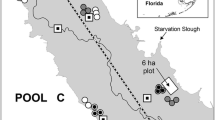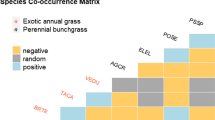Abstract
We studied spatial and temporal effects of local extinction of the plains vizcacha (Lagostomus maximus) on plant communities following widespread, natural extinctions of vizcachas in semi-arid scrub of Argentina. Spatial patterns in vegetation were examined along transects extending outward from active and extinct vizcacha burrow systems. Responses of vegetation to removal of vizcachas were assessed experimentally with exclosures and by documenting vegetation dynamics for 6 years following extinctions. Transect data demonstrated clear spatial patterns in plant cover, particularly an increase in perennial grasses, outward from active vizcacha burrows. These patterns were consistent with predictions based on foraging theory and studies that document grasses as the preferred food of vizcachas. Removal of vizcachas, experimentally and with extinctions, resulted in an immediate increase in perennial and annual forbs indicating that intense herbivory can depress forb cover, as well as grasses. After a 1-year lag following cessation of herbivory, cover of grasses increased. Forbs declined as grasses increased. The long-term effect of extinction of vizcachas was a conversion of colony sites from open patches dominated by forbs to dense bunch grass characteristic of the matrix. Major changes in vegetation occurred within 2–3 years after extinction, resulting in a large pulse of landscape change. However, some species of grasses were uncommon until 5–6 years after the vizcacha extinction. With extinction and colonization, vizcachas generate a dynamic mosaic of patches on the landscape and create temporal, as well as spatial, heterogeneity in semi-arid scrub.
Similar content being viewed by others
References
Anohorena JBN (1988) Pastizales naturales de La Pampa, vol II. CREA, La Pampa, Argentina
Andersson M (1981) Central place foraging in the whinchat, Saxicola rubetra. Ecology 62:538–544
Branch LC (1993a) Social organization and mating system of the plains vizcacha (Lagostomus maximus). J Zool 229:473–491
Branch LC (1993b) Intergroup and intragroup spacing in the plains vizcacha, Lagostomus maximus. J Mammal 74:890–900
Branch LC, Sosa RA (1994) Foraging behavior of the plains vizcacha, Lagostomus maximus (Rodentia: Chinchillidae) in semi-arid scrub of central Argentina. Vida Silv Neotrop 3:1–5
Branch LC, Villarreal D, Fowler GS (1993) Recruitment, dispersal, and group fusion in a declining population of the plains vizcacha (Lagostomus maximus; Chinchillidae). J Mammal 74:9–20
Branch LC, Villarreal D, Fowler GS (1994a) Factors influencing population dynamics of the plains vizcacha (Lagostomus maximus, Mammalia, Chinchillidae) in scrub habitat of central Argentina. J Zool 232:383–395
Branch LC, Villarreal D, Sbriller AP, Sosa RA (1994b) Diet selection of the plains vizcacha (Lagostomus maximus, family Chinchillidae) in relation to resource abundance in semi-arid scrub. Can J Zool 72:2210–2216
Branch LC, Pessino M, Villarreal D (in press) Response of mountain lions to a population decline of the plains vizcacha in semi-arid scrub of central Argentina. J Mammal
Brown JH, Heske EJ (1990) Control of a desert-grassland transition by a keystone rodent guild. Science 250:1705–1707
Cano E (1988) Pastizales naturales de La Pampa, vol I. CREA, La Pampa, Argentina
Coppock DL, Delting JK, Ellis JE, Dyer MI (1983) Plant-herbivore interactions in a North American mixed-grass prairie. Oecologia 56:1–9
Covich AP (1976) Analyzing shapes of foraging areas: some ecological and economic theories. Annu Rev Ecol Syst 7:235–257
Crawley MJ (1990) The population dynamics of plants. Philos Trans R Soc Lond B 330:125–140
Direccíón de Estadística y Censos (1981) Lluvias 1921–1980. Dirección de Estadistica y Censos, Santa Rosa, La Pampa, Argentina
Dirección de Estadística y Censos (1991) Lluvias registradas en la provincia de La Pampa. Dirrección de Estadística y Censos, Santa Rosa, La Pampa, Argentina
Dublin HT, Sinclair ARE, McGlade J (1990) Elephants and fire as causes of multiple stable states in the Serengeti-Marà woodlands. J Anim Ecol 59:1147–1164
Hobbs RJ, Mooney HA (1991) Effects of rainfall variability and gopher disturbance on serpentine annual grassland dynamics. Ecology 72:59–68
Holland EA, Detling JK (1990) Plant responses to herbivory and belowground nitrogen cycling. Ecology 71:1040–1049
Hoogland JL (1981) The evolution of coloniality in white-tailed and black-tailed prairie dogs (Sciuridae: Cynomys leucurus and C. ludovicianus). Ecology 62:252–272
Hunter MD (1992) Interactions within herbivore communities mediated by the host plant: the keystone herbivore concept. In: Hunter MD, Ohgushi T, Price PW (eds) Effects of resource distribution on animal-plant interactions. Academic Press, San Diego, pp 287–325
Huntly NJ (1991) Herbivores and the dynamics of communities and ecosystems. Annu Rev Ecol Syst 22:477–503
Huntly NJ (1995) How important are consumer species to ecosystem functioning? In: Jones CG, Lawton JH (eds) Linking species and ecosystems. Chapman and Hall, New York, pp 73–83
Huntly NJ, Inouye R (1988) Pocket gophers in ecosystems: patterns and mechanisms. Bioscience 38:786–793
Instituto Nacional de Tecnología Agropecuaria (1980) Inventario integrado de los recursos naturales de la provincia de La Pampa. Instituto Nacional de Tecnología Agropecuaria, Buenos Aires, Argentina
Jones CG, Lawton JH, Shachak M (1994) Organisms as ecosystem engineers. Oikos 69:373–386
King JA (1955) Social behavior, social organization, and population dynamics in a black-tailed prairiedog town in the black hills of South Dakota. Contrib Lab Vert Biol Univ Michigan 67:1–123
Llanos AC, Crespo JA (1952) Ecología de lo vizcacha (Lagostomus maximus maximus Blainv) en el Nordoeste de la Provincia de Entre Ríos. Rev Invest Agríc 6:289–378
Louda SM, Keeler KH, Holt RD (1990) Herbivore influences on plant performance and competitive interactions. In: Grace JB, Tilman D (eds) Perspectives on plant competition. Academic Press, San Diego, pp 413–444
McNaughton SJ (1992) The propagation of disturbance in savannas through food webs. J Veg Sci 3:301–314
Monk CD, Gabrielson FC (1985) Effects of shade, litter and root competition on old-field vegetation in South Carolina. Bull Torrey Bot Club 112:383–392
Norton-Griffiths M (1979) The influence of grazing, browsing, and fire on the vegetation dynamics of the Serengeti. In: Sinclair ARE, Norton-Griffiths M (eds) Serengeti: dynamics of an ecosystem. The University of Chicago Press, Chicago, pp 310–352
Orians GH, Pearson NE (1979) On the theory of central place foraging. In: Horn DJ, Mitchell RD, Stairs GR (eds) Analysis of ecological systems. State University Press, Columbus, Ohio, pp 155–177
Ostfeld RS, Canham CD (1993) Effects of meadow vole population density on tree seedling survival in old fields. Ecology 74:1792–1801
Pacala SW, Crawley MJ (1992) Herbivores and plant diversity. Am Nat 140:243–260
Pastor J, Naiman RJ, Dewey B, McInnes P (1988) Moose, microbes, and the boreal forest. Bioscience 38:770–776
Reichman OJ, Benedix JH, Seastedt TR (1993) Distinct animal-generated edge effects in a tallgrass prairie community. Ecology 74:1281–1285
Rice KJ (1987) Interaction of disturbance patch size and herbivory in Erodium colonization. Ecology 68:1113–1115
Sala OE (1988) The effect of herbivory on vegetation structure. In: Werger MJA, Aart PJM van der, During HJ, Verhoeven JTA (eds) Plant form and vegetation structure. SPB Academic Publishing, The Hague, The Netherlands, pp 317–330
Sarnelle O, Kratz KW, Cooper SD (1993) Effects of an invertebrate grazer on the spatial arrangement of a benthic microhabitat. Oecologia 96:208–218
SAS Institute (1990) SAS/STAT user's guide, Release 6.03. SAS Institute, Cary, North Carolina
SAS Institute (1992) Technical Report P-229, SAS/STAT software: changes and enhancements, release 6.07. SAS Institute, Cary, North Carolina
Sokal RR, Rohlf FJ (1981) Biometry Freeman, New York
Whicker AD, Detling JK (1988a) Ecological consequences of prairie dog disturbances. BioScience 38:778–785
Whicker AD, Detling JK (1988b) Modification of vegetation structure and ecosystem processes by North American grassland mammals. In: Werger MJA, Aart PJM van der, During HJ, Verhoeven JTA (eds) Plant form and vegetation structure. SPB Academic Publishing, The Hague, The Netherlands, pp 301–316
Author information
Authors and Affiliations
Rights and permissions
About this article
Cite this article
Branch, L.C., Villarreal, D., Hierro, J.L. et al. Effects of local extinction of the plains vizcacha (Lagostomus maximus) on vegetation patterns in semi-arid scrub. Oecologia 106, 389–399 (1996). https://doi.org/10.1007/BF00334567
Received:
Accepted:
Issue Date:
DOI: https://doi.org/10.1007/BF00334567




